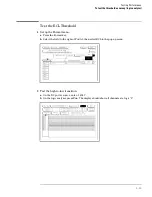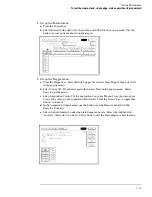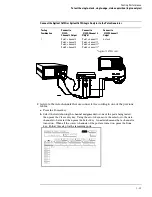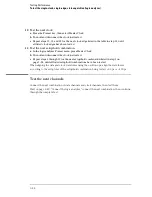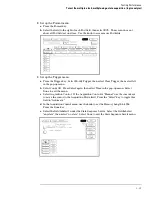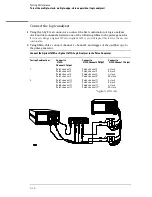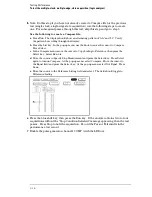
Verify the test signal
1
Check the clock period. Using the oscilloscope, verify that the master-to-master
clock time is 6.666 ns, +0 ps or
−
100 ps.
a
In the oscilloscope Timebase menu, select Scale: 1.000 ns/div.
b
In the oscilloscope Timebase menu, select Position. Using the oscilloscope knob,
position the clock waveform so that a rising edge appears at the left of the display.
c
On the oscilloscope, select [Shift] Period: channel 2, then select [Enter] to display the
clock period (Period(2)). If the period is not less than 6.666 ns, go to step d. If the
period is less than 6.666 ns, go to step 3.
d
In the oscilloscope Timebase menu, increase Position 6.666 ns. If the period is not less
than 6.666 ns, decrease the pulse generator Period in 10 ps increments until one of the
two periods measured is less than 6.666 ns.
2
Check the data pulse width. Using the oscilloscope, verify that the data pulse width
is 3.000 ns, +0 ps or
−
100 ps.
a
In the oscilloscope Timebase menu, select Position. Using the oscilloscope knob,
position the data waveform so that the waveform is centered on the screen.
b
On the oscilloscope, select [Shift] + width: channel 1, then select [Enter] to display the
data signal pulse width (+ width(1)).
c
If the pulse width is outside the limits, adjust the pulse generator channel 2 width until
the pulse width is within limits.
Testing Performance
To test the single-clock, single-edge, state acquisition (logic analyzer)
3–23
Summary of Contents for 1670G Series
Page 20: ...1 12...
Page 116: ...Testing Performance Performance Test Record pattern generator 3 92...
Page 126: ...Calibrating and Adjusting To test the CAL OUTPUT ports 4 10...
Page 166: ...Exploded View of the Agilent 1670G series logic analyzer Replacing Assemblies 6 4...
Page 201: ...Theory of Operation The Oscilloscope Board 8 11...





